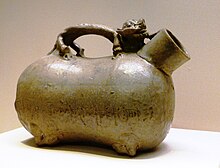Urinal (health care)


A urinal is a bottle for urination.[1] It is most frequently used in health care for patients who find it impossible or difficult to get out of bed. Urinals allow the patient who has cognition and movement of their arms to toilet independently. Urinals can also be used for measuring the amount of urine produced by a patient on input & output (I & O), even if not used by the patient for toileting.
Generally, patients who are able to are encouraged to walk to the bathroom or use a bedside commode as opposed to a urinal. The prolonged use of a urinal has been shown to lead to constipation or trouble urinating.[2]
Urinals are most frequently used for male patients, since they are easier to use with male anatomy. While female urinals exist, they are more difficult to use, and the common practice for females is to use a bedpan.[3] Female urinals require a wider opening and must be placed between the legs.[4] For many women, female urinals are more practical in a wheelchair rather than in a bed.[5]
References
- ^ http://books.google.com/books?id=GVwVAAAAIAAJ&pg=PA453&dq=urinal&as_brr=3&ie=ISO-8859-1&output=html
- ^ http://books.google.com/books?id=wqxcNyJBgNoC&pg=PA26&dq=urinal&as_brr=3&ie=ISO-8859-1&output=html
- ^ http://books.google.com/books?id=nz0bpa6oem8C&pg=PT887&dq=urinal&as_brr=3&ie=ISO-8859-1&output=html
- ^ http://books.google.com/books?id=wVfAX2NdloAC&pg=PA46&dq=female+urinal&lr=&as_brr=3&ie=ISO-8859-1&output=html
- ^ http://books.google.com/books?id=Da9A1yo4g_gC&pg=PA258&dq=female+urinal&lr=&as_brr=3&ie=ISO-8859-1&output=html
